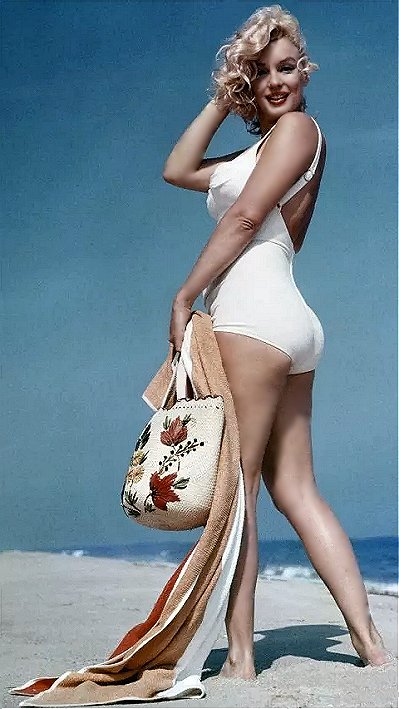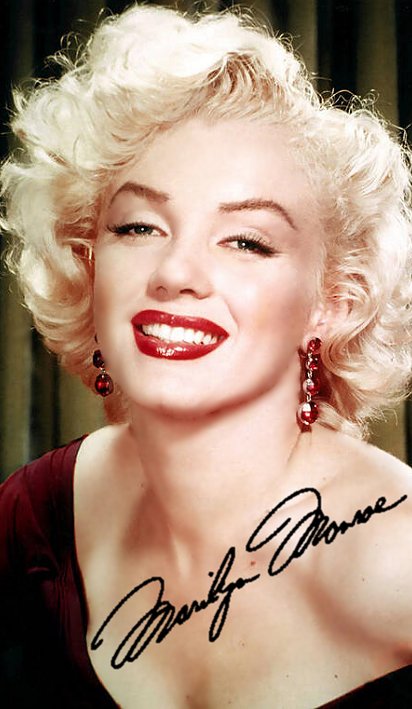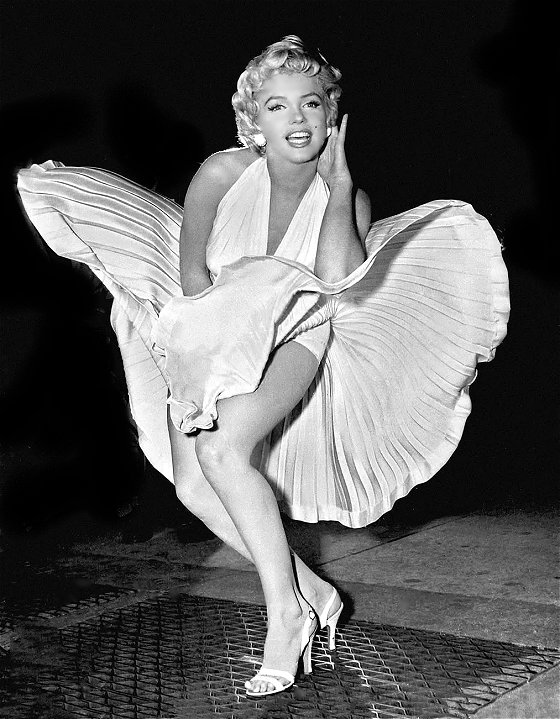Sixties
City presents
a wide-ranging series of
articles on all aspects of the Sixties, penned by the creator of the iconic
60s music paper Mersey
Beat
|
Sixties
City presents
a wide-ranging series of
articles on all aspects of the Sixties, penned by the creator of the iconic
60s music paper Mersey
Beat
|
|||||
|
 |
Golden
Dreams - The Story Behind Marilyn’s Famous Nude Calendar Pose “She was as graceful as an otter, turning sinuously with utter naturalness” commented photographer Tom Kelley when discussing the two-hour photo-session which produced the most sensational calendar for decades. “The athletic stretch of the 1940 Lo, pointing north by northeast, lying on her side, as lean as a steak, her stomach hard, her breast and haunch like buds on a twig” wrote one journalist of one of the poses Marilyn Monroe displayed during the famous session. Marilyn had been trying to find success in films for a few years, during which time she scraped together a living with a part-time modelling career while existing on hot dogs and coffee for 30 cents a day. She was determined to make a go of it in the movies, which is one of the reasons she was apprehensive about agreeing to a nude photo session. She’d posed for photos for beer commercials for Kelley during a four-to-five-year period, during which he had often asked her if she’d pose in the nude. She always refused, aware of what such a move could do to her planned career in films. Eventually, threatened with removal from the Studio Club (in those days tenants could be evicted without notice) because she was behind with her rent and with a finance company about to repossess her 1941 Pontiac and a phonograph, she finally phoned Kelley to agree to a session. Her two stipulations were that Tom’s wife, Natalie, had to be present as his assistant and the session should be shot in a way to make her face almost unrecognisable. The date was set for 27th May 1949 at 736 N. Sewart Street, Los Angeles, for a fee of $50. Kelley took approximately 24 shots, two of which became famous under the titles ‘Golden Dreams’ and ‘A New Wrinkle’ – 22 of the shots were later stolen from his studio. The photographer used a Deardoff View Camera and shot a number of variations in a rapid-fire exposure technique. ‘Golden Dreams’ was a profile version of the pose in which Marilyn was placed in situ on a background of red velvet while he perched above her, shooting down. Kelley had strobe lighting on in an attempt to obscure her features and the mood music in the background was Artie Shaw’s ‘Begin the Beguine’ which was played constantly throughout. The strobe lighting was also supposed to obscure her awareness of anyone else being in the same room. She signed the release form using the name Mona Monroe and with her $50 she paid her back rent and ate a quiet dinner alone and “enjoyed every bite”. Kelley sold the ‘Golden Dreams’ shot to Western Lithograph Company for $500. Three years later it was issued as a calendar. When 20th Century Fox found out, Marilyn was already becoming a star and, although she’d completed ‘Clash by Night’, the studio discussed cancelling her contract and withdrawing the film. In those days there was a ‘morality’ clause in film contracts. However, Marilyn suggested to the press executives at the studio that she should admit having posed in the nude while at the same time emphasising that she did it out of a need to pay the rent. They agreed and it was decided to slip it into an interview conducted by Aline Mosby, a female reporter with the powerful syndication United Press International. During the interview, Marilyn took Aline into the ladies cloakroom and made her ‘confession’. Moseby was sympathetic and the story was syndicated on 13th March 1952. It read: 'A photograph of a beautiful nude blonde on a 1952 calendar is hanging in garages and barbershops all over the nation today. Marilyn Monroe admitted today that the beauty is she. She posed stretched out on rumpled red velvet for the artistic photo three years ago because “I was broke and needed the money. Oh, the calendar’s hanging in garages all over town” said Marilyn. “Why deny it? You can get one any place. Besides, I’m not ashamed of it. I’ve done nothing wrong.” The beautiful blonde now gets a fat paycheck every week from an excited 20th Century Fox Studios. She’s rated the most sensational sweater girl since Lana Turner. She lives in an expensive hotel room. She dines at Romanoff’s, but in 1949 she was just another scared young blonde, struggling to find fame in the magic city, and all alone. As a child she lived in a Hollywood orphanage. She was pushed around among 12 sets of foster parents before she turned an insecure 16. After an unsuccessful marriage, she moved into Hollywood’s famed Studio Club, home of hopeful actresses. “I was a week behind on my rent” she explained. “I had to have the money. A photographer, Tom Kelley, had asked me before to pose but I’d never do it. This time I called him and said I would as soon as possible, to get it over with. His wife was there. They’re both very nice. We did two poses, one standing up, with my head turned profile, and another lying on some red velvet”. Marilyn speaks in a breathless, soft voice, and she’s always very serious about every word she says. “Tom didn’t think anyone would recognise me” she said. “My hair was long then, but when the picture came out, everybody knew me. I’d never have done it if I’d known things would happen in Hollywood so fast for me”. Marilyn’s bosses at plushy Fox Studios reached for the ulcer tablets when the calendar blossomed out in January. “I was told I should deny I’d posed, but I’d rather be honest about it. I’ve gotten a lot of fan mail on it. The men like the picture and want copies. The women, well…. One gossip columnist said I autographed the pictures and handed them out and said ‘Art for Art’s sake’. I never said that. Why, I only gave two away” said Marilyn, and blinked those big, blue eyes. It was a PR success and ‘Clash by Night’ did great business while Marilyn’s career received a further boost. The Chicago firm sold eight million calendars and when the U.S. Post Office ruled that it was obscene, a committee of well-known artists was formed to judge the pose and they commented that it was ‘a work of art in perfect symmetry’ which prevented it from being banned in the mail. |
 |
 |
The Shot Seen Around The World The image of Marilyn Monroe standing above an air vent, with her skirts blowing in the air, is one of the most potent popular images of the 20th Century. One of the most famous scenes in cinema history is to be found in Billy Wilder’s film ‘The Seven Year Itch’. Marilyn Monroe, laughing with delight, stands above an air vent to cool herself down on a hot night in New York and has her dress blown high into the air. Certainly, since the scene was filmed over decades ago, its images have been used in countless advertising campaigns, posters and photographs which have recreated it. The scene was innocent in its sexuality but it provoked such a conflict between Marilyn and Joe DiMaggio, her husband at the time, that it broke up the marriage. Tom Ewell portrayed a family man who remained at home in his apartment during the hot summer months when the rest of his family had decamped for the country. Marilyn portrayed ‘the girl upstairs’. The crew flew to New York in September, 1954, for location filming. Production manager Johnny Graham had to deal with the complex logistics of filming in a New York street. The setting was the outside of the Trans-Lux Theatre on 52nd street and Lexington Avenue. There was a nearby cinema screening ‘The Creature from the Black Lagoon’ and the cluster of businesses which received such invaluable publicity included Wright’s Food, the Henry Steig Workshop, Flourette Jewellery and a liquor store. A portable air blower was placed beneath a subway grating. It was tested by a grip and the scene was ready to be shot. Cameras and lighting equipment had been moved in, the studio had cordoned off the block and a few thousand New Yorkers were lined up behind the barriers. Around midnight a limousine arrived, and Marilyn got out. She wore a sweater over her shoulders which she took off when she began to rehearse the scene with Tom Ewell. She wore a backless white dress with pleated flounce skirt, white shoes and white panties. The crowd hadn’t known what to expect but when Marilyn stood above the grating and the wind blew her skirts into the air there were shouts of ‘Hurrah!’ and ‘Higher, higher!’ Joe DiMaggio had travelled to New York with Marilyn and he stood by the crowd, grim and unsmiling. As the crowd continued to cheer with each succeeding take, DiMaggio began to walk away. One of the newsmen asked him, “What do you think of Marilyn having to show more of herself than she’s shown before?” DiMaggio didn’t answer. Marilyn returned to the hotel shortly after four in the morning and other residents claimed they heard the sounds of shouting and hysterical weeping. DiMaggio left for California the following day and the couple were divorced some months later. The next day photographs of the scene appeared on the front pages of newspapers throughout the world and have continued to appear in magazines, books and papers ever since. The Haystack Brunette and The Blowtorch Blonde - Jane Russell and Marilyn in ‘Gentlemen Prefer Blondes’ When it was announced that Marilyn Monroe and Jane Russell were to star in ‘Gentlemen Prefer Blondes’ the press thought they’d have a heyday and stir up a feud between the sex symbols, with one columnist calling it ‘The battle of the bulges’. They were out of luck! The two actresses got along fine together and Jane, who was more confident in herself, took a maternal interest in Marilyn, even helping her to choose an apartment. She said, “We get along great together. Marilyn was very shy and very sweet and far more intelligent than people gave her credit for”. Both had attended Van Nuys High School in California, but at different times and Jane had previously met Marilyn with her first husband, Jim Dougherty, who Jane had appeared with in school plays. At the time of filming ‘Gentlemen Prefer Blondes’ Marilyn was being dated by Joe DiMaggio and as Jane was married to Bob Waterfield, a retired football player, Marilyn asked her advice about marrying a famous sports player. She was told, “Well, they’re birds of a feather and you’ll get to know lots of other athletes – otherwise, it’s great”. Commenting on the movie in her autobiography, Jane wrote, “I had a ball on that picture, but I don’t think Marilyn did altogether, because she was torn between the front office, who was calling her a cheap, dumb blonde, and Natascha Lytess, her drama coach who worked with her every night”. Jane pointed out that "things started going wrong when Natascha began directing Marilyn on the set. Whenever a scene was finished, Marilyn would immediately turn to Natascha for her opinion. This began to annoy Howard Hawks, who was directing the picture. As Jane pointed out, Hawks was 'a director that even producers didn’t interfere with. He was lord of the set'. Finally, Hawks threw Natascha off the set, but things continued to get strained. Marilyn started coming to the set late and that didn’t go over too well, so I talked to Whitey (Marilyn’s hairdresser). He told me she came in long before I did and was really ready. But she’d stay in her dressing room and potter. ‘I think she’s afraid to go out’ he said. So from then on I’d stand in her doorway and say, ‘Come on, Blondie, let’s go’ and she’d say, ‘Oh, okay’, in her whispery voice, and we’d go on together. She was never late again”. The film was a box office success and the press called the combination ‘The Haystack Brunette versus the Blowtorch Blonde’. To promote the picture further, the two actresses were invited to place their footprints, handprints and signatures in the cement at Grauman’s Chinese Theatre on Hollywood Boulevard. "We were both wearing light, summery dresses and high heels as we posed, arms linked together, for the photographers. We were thrilled” said Jane. As Jane was renowned for her bosom and Marilyn for her bottom, Marilyn suggested that Jane bend down and place her bust in the cement and she’d do the same with her buttocks, but the organisers rejected the idea. Marilyn also suggested that a diamond be placed about the ‘I’ of her signature. Instead, a rhinestone was substituted which, not surprisingly, was stolen soon afterwards. When asked about her relationship with Jane, Marilyn told a reporter, “We got along nicely – Jane called me the ‘round one’ – I don’t know what she means by that, but I assume she means it to be friendly”. ‘Gentlemen Prefer Blondes’ was one of the big money spinners of the year, due in no small measure to Marilyn’s charisma, yet for her appearance in the movie Marilyn was paid only $18,000, while Jane received a payoff of $100,000. |
|
Article
Text
UK
web hosting by
|